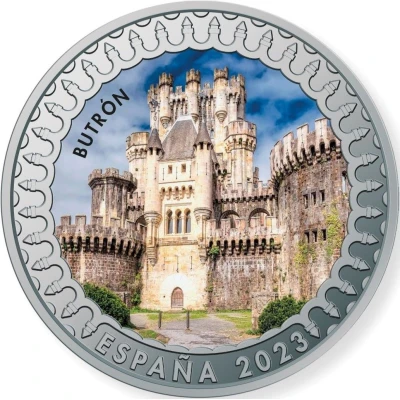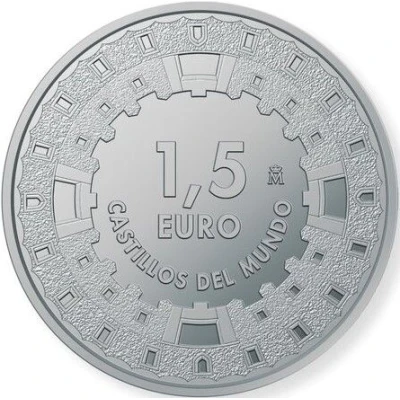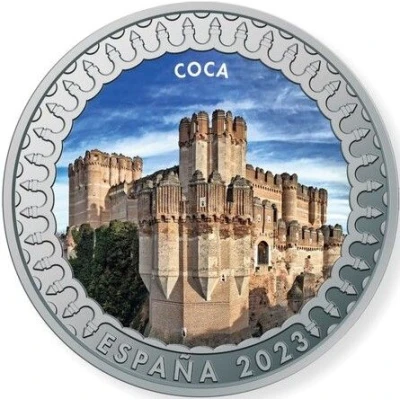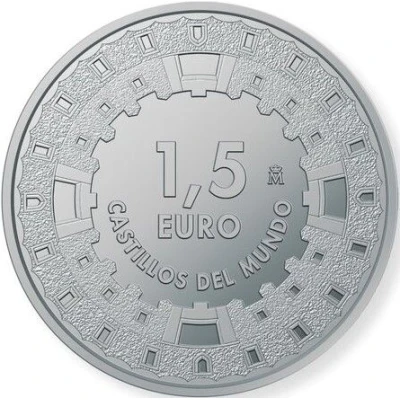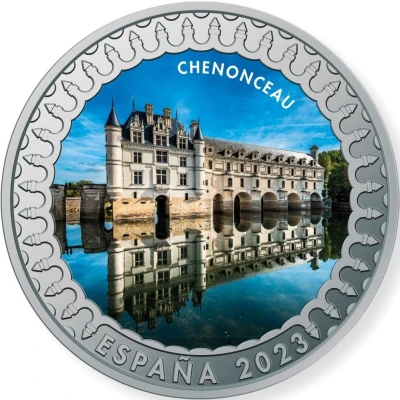


Obverse © Real Casa de la Moneda – Reverse © Aureo & Calicó S.L., subastas numismáticas
1.5 Euro Castle of Chenonceau
2023 year| Copper-nickel (75% copper, 25% nickel) | 15 g | 33 mm |
| Issuer | Spain |
|---|---|
| King | Felipe VI (2014-date) |
| Type | Non-circulating coin |
| Year | 2023 |
| Value | 1.5 Euro 1.50 EUR = USD 1.65 |
| Currency | Euro (2002-date) |
| Composition | Copper-nickel (75% copper, 25% nickel) |
| Weight | 15 g |
| Diameter | 33 mm |
| Shape | Round |
| Technique | Milled, Coloured |
| Orientation | Medal alignment ↑↑ |
| Updated | 2024-10-07 |
| Numista | N#383807 |
|---|---|
| Rarity index | 97% |
Reverse
On the outside part of the the reverse (common to all the coins), allegory of the structure of the castles.
Script: Latin
Lettering:
CASTILLOS DEL MUNDO
1,5 EURO
M
Translation: Castles of the World
Edge
Plain
Comment
Chenonceau Castle: What is known as the “castle of the ladies” was built as a residence in the 16th century by Thomas Bohier and his wife, Katherine Briçonnet, on the foundations of a former castle and fortified mill formerly owned by the Marques family, of which only the keep was preserved, and later decorated in Renaissance style, and the adjoining well.Built on the banks of the River Cher, the Château de Chenonceau is the most visited historic monument in France under private ownership, and from its very inception, it was given a personal touch by a number of different women, both in its construction and in the profuse and exquisite decoration of its many rooms.
It was Katherine Briçonnet who directed the initial construction work, as her husband was busy with other matters. After the death of Thomas Bohier, the château passed into the hands of the French royal family, and King Henry II gave it to his mistress, Diane de Poitiers, who commissioned the construction of the gardens that still bear her name, and the building of a bridge to link the château to the other side of the river Cher, where new gardens could be laid out.
After Henry II’s death, his wife, the queen consort Catherine de’ Medici, expelled Diane de Poitiers from the castle and forced her to hand it back to the crown, after which she built a two-storey gallery over the bridge that Diane had built, and had its rooms and halls redecorated to erase the presence of her late husband’s mistress.
Henry III’s wife, Louise de Lorraine, received the château from Catherine de’ Medici, and after her husband's assassination, she shut herself up in it, turning it into something of a convent where mourning and austerity prevailed, as can be seen in her chambers, whose coffered ceilings, religious decoration evocative of mourning and the macabre paintings hanging on the walls are predominantly black.
The winds of the French Revolution were not unfavourable to the Château de Chenonceau, thanks to the Dupin family, who acquired the château in 1733 and taking it into private ownership, and it has remained so until the present day, having had many owners over the years, as well as many distinguished visitors.
The extraordinary beauty of this French château, part of the famous châteaux of the Loire Valley route, lies as much in its soft and elegant exterior forms as in its gardens – brimming with colour and good taste – its rose gardens and poplar groves, statues, mazes, flowerbeds and fountains, as well as the unparalleled luxuriance of the decoration of its rooms, vestibules and halls, spaces where the art of detail and refinement reign.
Interesting fact
The Castle of Chenonceau coin has a unique feature - it's a non-circulating coin, meaning it's not meant to be used as regular currency, but rather as a collector's item.
Price
| Date | Mintage | VG | F | VF | XF | AU | UNC |
|---|---|---|---|---|---|---|---|
| 2023 M | 5000 | - | - | - | - | - | - |
Values in the table are based on evaluations by sales realized on Internet platforms. They serve as an indication only for 1.5 Euro (Castle of Chenonceau) 2023 coin.
